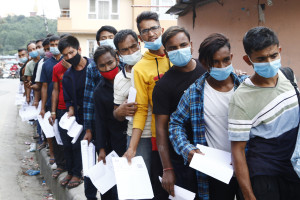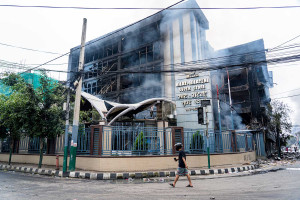Money
India expands electronic cargo tracking system for Nepal-bound shipments
Move allows cargo movement through more ports and new railroad routes, easing trade procedures and reducing transit time.
Krishana Prasain
The Indian government has expanded the electronic cargo tracking system for Nepal-bound shipments, allowing transit cargo movement through additional Indian ports and a new rail-road route. Officials say the move will simplify procedures, reduce transit time, ease pressure on key ports, and enhance cargo movement security.
Amending the Transhipment of Cargo to Nepal under Electronic Cargo Tracking System Regulations, 2019, the Central Board of Indirect Taxes and Customs (CBIC) issued a notification on Tuesday, making the decision effective immediately.
The electronic cargo tracking system (ECTS) is a technology-based solution for real-time monitoring of cargo during transit. It uses GPS or GPRS, electronic seals, and sensors to give customs authorities and traders visibility over the cargo’s location and security. The system is designed to enhance trade efficiency, reduce tax evasion, and improve transparency, though it comes with costs and logistical challenges in implementation and maintenance.
Transhipment cargo refers to goods transferred from one mode of transport to another—such as from one ship to another—at a hub port before reaching the final destination. This process is used when there is no direct transport route, requiring cargo to be unloaded and reloaded at an intermediate port.
According to the CBIC notification, the transhipment of cargo will now be implemented from the ports of Kolkata, Haldia, and Visakhapatnam in India to Birgunj in Nepal by rail, from Batnaha in India to Biratnagar in Nepal by a rail-road combination, and from the Indian customs yard at Jogbani to Biratnagar by road. Biratnagar will also receive cargo directly by rail from India.
Trade and logistics expert Rajan Sharma said that, until now, container cargo with electronic tracking was limited to the Birgunj Integrated Check Post. “As cargo can now reach Biratnagar directly, imports via Visakhapatnam will be much easier and faster. This will especially benefit entrepreneurs and traders in the eastern region,” he said.
Sharma added that the expanded system will facilitate the import of goods with fewer damages, reduce paperwork, and save time. “Nepal had long been requesting the expansion of the electronic cargo tracking system,” he said.
The amendment also aligns with India’s obligations under the India-Nepal Transit Treaty, which grants Nepal access to multiple trade routes through Indian territory. It supports India’s commitment under the World Trade Organisation’s Trade Facilitation Agreement to use technology for streamlining customs procedures, Indian media reported.
“With the inclusion of Visakhapatnam port and additional transit corridors, exporters in southern and eastern India will now have alternative gateways to reach Nepal, reducing dependence on the congested Kolkata-Birgunj route,” reports said.
Nepal’s use of electronic cargo tracking began in February 2019, alongside the implementation of transhipment privileges from Indian authorities. The system allows goods imported from third countries to undergo customs clearance directly at the Nepal-India border customs points, without being opened or inspected at Indian ports.
Supported by the Asian Development Bank, the electronic cargo tracking system is recognised as an effective anti-smuggling and anti-transit fraud mechanism that helps boost government revenue.
In June 2017, India and Nepal signed a memorandum of intent to pilot the tracking system for cargo transiting by road and rail from Kolkata to major customs points in Nepal, including Birgunj via Raxaul, Sirsiya inland container depot via Raxaul, Biratnagar via Jogbani, and Bhairahawa via Sunauli.
India remains Nepal’s largest trading partner, with total bilateral trade reaching Rs1.29 trillion in the last fiscal year ended mid-July. According to Nepal’s Department of Customs, the country exported goods worth Rs224.68 billion and imported goods worth Rs1.07 trillion during the period.
Although Nepal currently uses an electronic cargo tracking system, trade experts say it only provides transport details and lacks comprehensive data on the shipments’ contents. They argue that implementing a robust “pre-information system” would help reduce customs-related corruption and improve transparency.
In April, at the 21st Nepal-India Customs Administration Director General Level Meeting held in Kathmandu, India had agreed to implement the pre-information system for exports and imports within a month. However, it has yet to be put into effect.




 8.12°C Kathmandu
8.12°C Kathmandu















